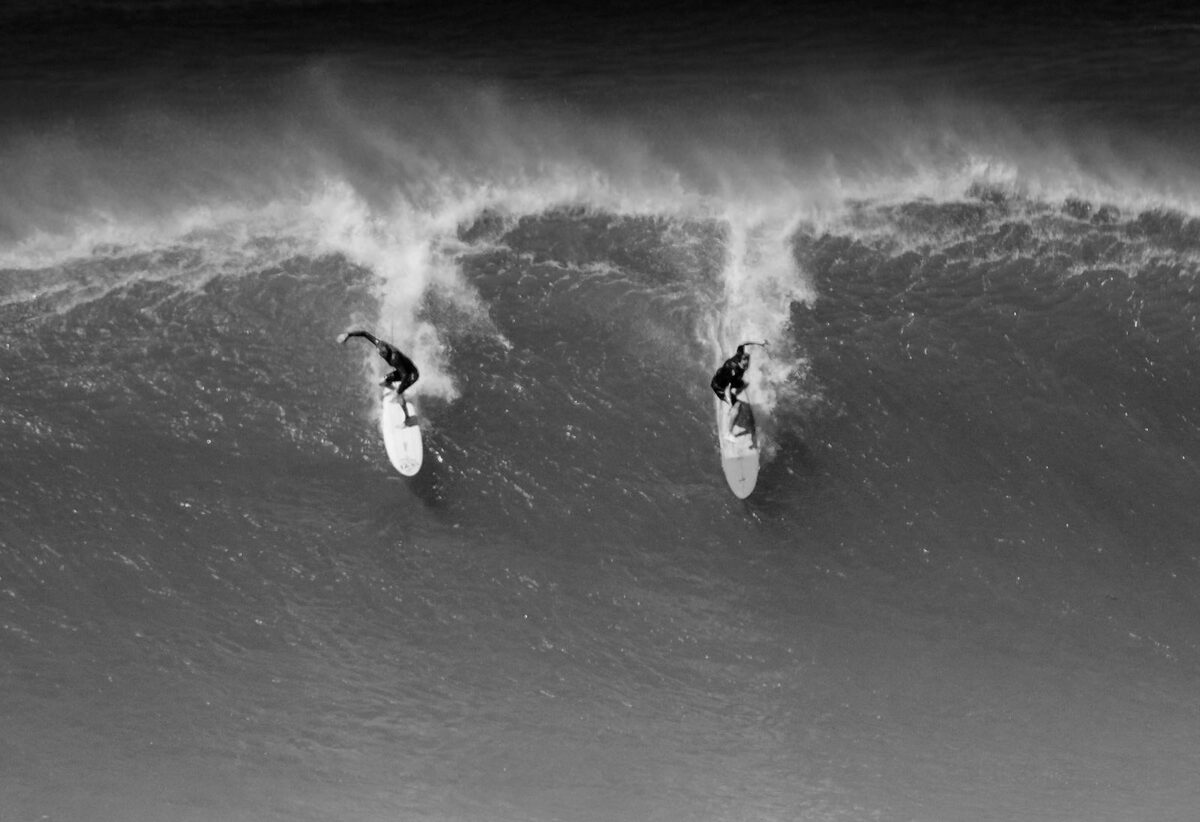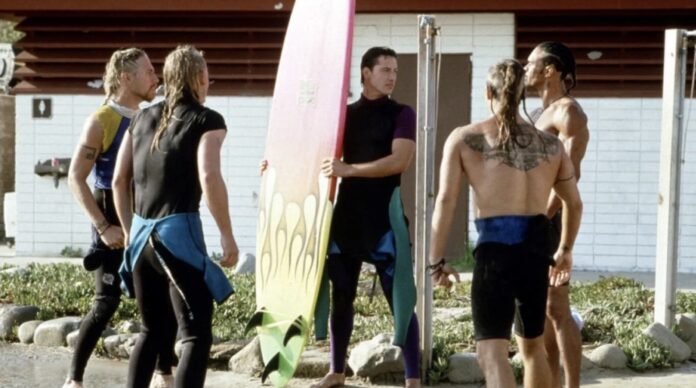In this article, we explore aggression in surfing, our zen-like sport.
The Northern Locals
It was early morning on the Northeast coast. I awoke, grabbed my twin fin from the car, and headed towards the bay. The seagulls that could be heard from the car park didn’t remind me much of the ocean. But the car horns were more familiar. They echoed against the cliff walls before continuing on beyond the water. As I passed the coastguard cottages, the sounds of breaking waves were drowned out by the riot of a father getting his kids ready for school. It’s surprising how far the frustrations of a tired parent will travel on a calm day. Sometimes they’re carried on offshore winds until a surfer, way out in the water, hears them and smiles – the sounds of the sea.
Once I reached the sand, the sounds I could hear were quickly overshadowed by the ones I couldn’t quite. It was light enough by then to make out two surfers talking to each other while pointing in my direction. Between the two surfers and where I was standing, a World War Two bunker lay half embedded in the shore. The words ‘Locals Only’ and ‘Do Not Surf Here’ had been sprayed across the concrete carcass in black and red. Some say this brand of exclusionary localism was started by Malibu surfers with Nazi sympathies. So it was quite fitting that these locals had targeted an Allied war bunker. But regardless the sentiment was clear, outsiders were not welcome at their wave.
But regardless the sentiment was clear, outsiders were not welcome at their wave.
Those words were as clear in their statement of exclusion as in their sense of entitlement, but hostility towards non-locals is rare in the Northeast. Perhaps then it was just a bad joke. The groms who wrote it are probably adults now, maybe the two surfers across the beach, and maybe they cringe every time they walk past their handiwork. In that case, the warning on the bunker was harmless. A silly scribble. One that had no more power to stop me than I had power to paddle out and surf that forbidden corner of the North Sea.

Surfing’s Dark Side
As I sat out in the line-up that day, my mind drifted to surfing’s dark side. Our sport has always had an interesting relationship with violence. Wave riding is the epitome of flow, yes. But we also carve and hack. We attack the sections of a wave. I once read that the language of creativity is violence, and if that is true, then surfing is bilingual. As surfers, our love for the tranquillity of the ocean has always been tempered by our addiction to its most brutal and unforgiving states. And yet there is a harmony in surfing that comes despite this abundance of violence, or maybe even because of it.
The dark side of surfing hints at something more specific. A violence that originates in ‘localism’ – the practice of surfers claiming authority and exclusive rights over the waves close to their homes. Localism has been a prominent part of surf culture for many decades. It goes way beyond graffiti. In fact, it is here that our zen-like sport gives way to gangs, aggression and exclusion.
Surf Gangs: California’s Surf Nazis
Daniel Duane is proficient surfer and an even better writer. He too became acquainted with the graffiti of local surfers after moving to California in the 1980’s. As Duane describes it, the graffiti of 80’s California is similar to that of the Northeast coast, with one striking difference. Next to the phrase ‘Kooks go home’, sprayed on the concrete steps of a Californian beach – a swastika.
The phenomenon of California’s surf Nazis began in the 60’s with the rise of Miki Dora, the ‘King of Malibu’. Dora resented surfing’s rise in popularity and the subsequent increase in outsiders descending on his local wave. It is often said that he popularised the exclusionary practices of localism, becoming infamous for committing violence against non-local surfers at his home break. Aggressive locals such as Dora became known as ‘Surf Nazis’, a reference to their militant behaviour, but perhaps also to their latent Nazi sympathies. In his piece, ‘The Long, Strange tale of California’s Surf Nazis’, Duane describes how the Malibu crew would dress in Nazi uniforms in a number of their surf films and paint swastikas around their supposed territory, including on the driveway of a prominent Jewish surfer.

Image Sourc: eos.surf
All of this has been shrugged off as an act of rebellion at one point or another. It was just a way to piss people off. Yet the reality is the actions of California’s surf Nazis were extreme and hateful. It is perhaps hardly surprising that this era also gave us the archetype of a Californian surfer as white, blonde and blue-eyed. And though things have improved in more recent years, with new initiatives that promote diversity and inclusivity in our line-ups, this legacy of exclusion remains entrenched in surfing culture through hostile attitudes towards non-locals.
Surf Gangs: Da Hui
The Da Hui of the North Shore of Oahu are not a real gang; they are a group of friends. Yet under the guise of protecting Hawaiian values, they have committed real violence. The Da Hui formed in 1976 and quickly began disrupting surf contests and attacking foreign surfers, creating a hostile atmosphere along 7 miles of Hawaii’s famous North Shore beaches. This story might seem familiar at first. Another case of entitled locals resenting a rise in the popularity of their sport and the end of their exclusive rein over local waves. But the story of the Da Hui is more complex.
Like many Hawaiians, the members of Da Hui believe Hawaii to be an independent nation under military occupation by the United States, as their ancestors never formally relinquished the sovereignty of their land. The rise of Da Hui has to be seen with this context in mind. The colonial overtones reversed when compared with the example of the Malibu crew. This is a group that emerged because some native Hawaiians were concerned by the influx of Australian and mainland American surfers descending on the North Shore, often followed by powerful corporate interests. It is not hard to see how this could have opened old wounds. And although this does not justify the violent actions of some Hawaiian surfers, it does go some of the way towards explaining them.
The Ethics of Localism
The case of Da Hui highlights some of the more complex ethical questions we have to navigate when discussing localism. We likely agree that it is important to protect places of natural beauty from hordes of tourists. And it is obviously wrong for corporate interests to exclude locals from their ‘own’ waves, at least in most circumstances. Yet it seems morally suspicious for a French national to have more of an entitlement to the Alps by virtue of their birthplace, and why should the ocean be any different? Can locals claim legitimate authority over a wave because of their proximity to it, given that where we are born is a matter of luck and privilege?
The answers to these questions are nuanced and context-dependent, but they are also secondary to a larger issue: the exclusionary sentiment in surfing. These questions only become relevant once we begin to think of waves as a scarce resource. And yet waves are an infinite resource. To some degree then we only become absorbed by the ethics of localism when surfing has already lost its way. Too often our exclusionary narrative confuses itself with a universal one. How often do we stop to question the rule of one per wave?
At its best, surfing can offer us a sense of ego-loss that is completely at odds with success over others or ownership over waves. The more we remind ourselves that waves are infinite, the more we are willing to share those that come our way, and the more we begin to move past the aggression in our zen-like sport.






